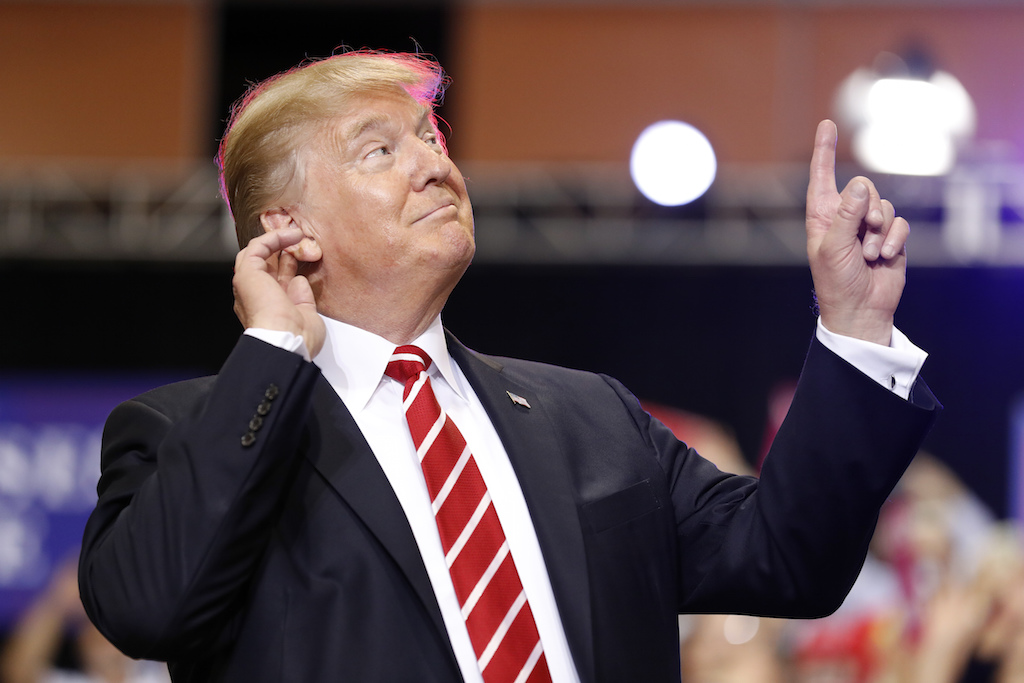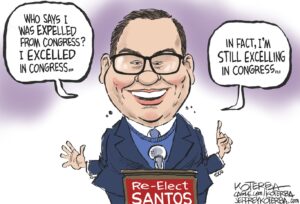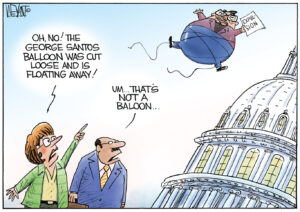Existing Law May Not Solve Presidential Crisis
For those looking to oust Donald Trump, don’t pin your hopes on impeachment, indictment or the 25th Amendment. What's that you say? Getting rid of Trump won't be as easy as 1, 2, 3. (Alex Brandon / AP)
What's that you say? Getting rid of Trump won't be as easy as 1, 2, 3. (Alex Brandon / AP)
For those of you looking for a legal avenue to cut short the tenure of the 45th president of the United States—our very own real-life madman in the high tower—I have some good news, and some bad.
Starting with the upside, your ranks are growing. According to a Public Policy Polling survey conducted in late September, 48 percent of American voters want Trump impeached. A Harvard-Harris Poll conducted a month earlier pegged support for impeachment at 43 percent.
You can also take comfort in the fact that you’re right to regard Trump as a unique threat to democratic values and institutions, not to mention world peace. From his almost-daily diatribes against the “fake news” media to his Twitter taunting of Kim Jong Un, he’s proved as much over the past nine months.
Although I’m about to drop some bad news as well, let me add first that I’m with you. I have been a “never Trumper” ever since the trash-talking real estate mogul descended an escalator at his midtown Manhattan headquarters in June 2015 to announce his bid for the presidency, pledge to “make America great again” and denounce undocumented Mexican migrants as criminals, rapists and purveyors of drugs.
Throughout the long and bizarre campaign that followed, I warned in multiple Truthdig pieces of the grave dangers a Trump presidency would pose in such areas of law and policy as freedom of the press, birthright citizenship, immigration enforcement and travel bans, climate change, abortion rights and future appointments to the Supreme Court.
I also was among the first to sound the alarm about Trump’s emotional stability, in a column titled “The Psychopathology of Donald Trump,” published in July 2016. The subject is now the focus of a best-selling book, “The Dangerous Case of Donald Trump,” featuring essays by 27 distinguished mental health experts.
Since the election, rather than mourn the defeat of Hillary Clinton, I’ve looked ahead, not back. Eyes fixed on Trump, I’ve explored the actual prospects for impeaching the president, as well as indicting him for obstruction of justice, stemming from the firing of former FBI Director James Comey.
But now for the downside: There is no quick legal fix for removing Trump. As long as the GOP controls Congress, impeachment remains a long shot, as it requires a majority vote in the House in favor of articles of impeachment and a two-thirds vote in the Senate to obtain a conviction and removal from office. Two House Democrats—Al Green of Texas and Brad Sherman of California—have introduced impeachment resolutions, but at present they’re going nowhere.
And while Robert Mueller’s investigation of Russian meddling in the election and the dismissal of Comey may result in the prosecution of such former Trump associates as Paul Manafort, Michael Flynn and even Donnie Jr., it’s premature to think that the president will find himself in the crosshairs of a grand jury any time soon. Although the issue remains unsettled, the weight of scholarly opinion is that a sitting president cannot be indicted.
The same, unfortunately, holds true for invoking the 25th Amendment—the latest deus ex machina championed by leading Democrats as a means for sacking Trump. If anything, the amendment is a more implausible vehicle than impeachment.
Ratified in 1967, the 25th Amendment was crafted in the aftermath of the assassination of John F. Kennedy to clear up ambiguities and fill gaps in the Constitution’s original provisions on presidential succession.
The Constitution, as it emerged from the founding convention of 1787, addressed the issue of succession in Article II, Section I, which stipulates:
In case of the removal of the President from office, or of his death, resignation, or inability to discharge the powers and duties of the said office, the same shall devolve on the Vice President, and the Congress may by Law provide for the case of removal, death, resignation, or inability, both of the President and Vice President, declaring what officer shall then act as President and such officer shall then act as President and such officer shall act accordingly, until the Disability be removed or a President shall be elected.
The rule of vice-presidential succession was restated by the 12th Amendment, which dealt primarily with the Electoral College and was ratified in 1804. The 20th Amendment, ratified in 1933, offered more clarification, stating that if the president-elect dies before being sworn into office, the vice president would be sworn in instead.
However, not until 1947, with the passage of the Presidential Succession Act, did the current line of succession take shape, extending from the vice president through the speaker of the House, the president pro tempore of the Senate, the secretary of state, and then to other Cabinet officials.
Still, questions about succession remained—among them, how to define a president’s inability to serve, particularly when the inability is mental or emotional in nature. Who gets to make the determination that such an inability exists? And can the president resist efforts to have himself declared unable to serve?
This is where Section 4 of the 25th Amendment comes into play in the debate over Trump’s mental fitness to hold the most powerful office in the land. The first paragraph of Section 4 advises:
Whenever the Vice President and a majority of either the principal officers of the executive departments [the Cabinet] or of such other body as Congress may by law provide, transmit to the President pro tempore of the Senate and the Speaker of the House of Representatives their written declaration that the President is unable to discharge the powers and duties of his office, the Vice President shall immediately assume the powers and duties of the office as Acting President.
The second and final paragraph of Section 4 instructs, in so many words, that the president can attempt to override a declaration of inability by notifying the Senate and House leadership that no such inability exists. Thereafter, the vice president, with the support of a majority of the Cabinet, or “the other body” referred to in the first paragraph, can contest the president’s override. To resolve the conflict and place the vice president in charge, a two-thirds vote of both houses of Congress is required to confirm that the president is, in fact, “unable to discharge the powers and duties of his office.”
The procedures outlined in Section 4 have never been invoked, and it is unlikely that they will be used against Trump. The amendment simply contains too many moving parts and depends on too many external contingencies to make it a viable option.
First and foremost, only the most cockeyed optimists could believe that Vice President Mike Pence would lead what would amount to a de facto palace coup against Trump by initiating the procedures outlined in Section 4. Nor, as an aside, would the nation be better off by having Pence—a religious fanatic and radical homophobe—take charge of the federal government.
Second, it is doubtful that Congress, acting without Pence, would enact legislation creating another body that would make a finding of presidential incapacity. To be sure, two bills are pending in the House to do just that. Maryland Democrat Jamie Raskin introduced one to establish an oversight commission on presidential capacity, staffed largely by physicians and psychiatrists. Earl Blumenauer, D-Ore., authored the other bill, which would create an oversight body composed of all former living presidents and vice presidents.
Neither measure, however, has shown any sign of progressing to a committee hearing. Even assuming, improbably, that either could win approval by both the Senate and the House and become law, they would have to be passed by a two-thirds supermajority in each chamber to withstand an inevitable presidential veto.
This does not mean, however, that it is pointless to agitate for impeachment or call for the removal of Trump via the 25th Amendment, or that it is a waste of time to discuss the possibility that Mueller and his colleagues will conclude they can prove an obstruction case against the president. Rather, it means that progressives and never-Trumpers should view the avenues for creating an early Trump exit not just as ends in themselves, but as organizing tools that can draw increasing numbers of Americans into a wider political effort to build a new progressive movement aimed at sweeping the GOP (and eventually, center-right Democrats) from power.
In the final analysis, and most importantly, dumping Trump and ensuring that no one like him ever accedes to the presidency again will require the promotion of an alternative to oligarchic corporate capitalism. As I have written in this column before:
Every major movement of social and political transformation, in addition to championing specific short-term reforms, has been animated by higher principles promising both solidarity and liberation. The American Revolution was moved by the demand for “life, liberty and the pursuit of happiness.” The French version was driven by the ideals of “liberté, égalité, fraternité.” The civil rights movement was propelled by Martin Luther King Jr.’s “dream” of racial harmony and justice. Even Obama’s 2008 presidential run was keyed by a single word of inspiration: “Hope.”
What, then, in this critical hour, is our shared vision of the future? I don’t pretend to have the answers, except to say that in the broadest terms it will be communitarian, diverse, inclusive, respectful of democratic institutions and the environment, and welcoming toward individual freedoms. It will not, if it is to succeed, call for a restoration of the hierarchical neoliberalism of the recent past.
The outcome is uncertain, which only makes the undertaking all the more urgent.
Your support matters…Independent journalism is under threat and overshadowed by heavily funded mainstream media.
You can help level the playing field. Become a member.
Your tax-deductible contribution keeps us digging beneath the headlines to give you thought-provoking, investigative reporting and analysis that unearths what's really happening- without compromise.
Give today to support our courageous, independent journalists.






You need to be a supporter to comment.
There are currently no responses to this article.
Be the first to respond.